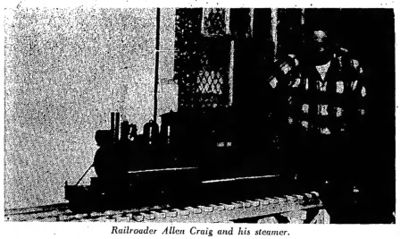Allen G. Craig
A Dalton Man Shows Off His Homemade "Steamer"
The Berkshire Eagle, Saturday, July 19, 1969
Allen Craig Spent 2,000 Hours Building Powerful Miniature

DALTON, MA -- Allen G. Craig of 41 Sunnyside Drive has the distinction of owning the only live-steam miniature locomotive in Berkshire County.
The "steamer" was declared to be the "hit of the show" at the Hudson-Berkshire Division of the National Model Railroad Association Show which was held in Pittsfield, MA last stpring. The purpose of the show, which was held at St. Stephen's Church and attended by o0ver 800 people, was to generate interest in live steam engines. Many models, collections and layouts were on display, but the live steamer from Dalton was the center of attraction.
Craig began work on his steamer 12 years ago when living in Johnstown, N.Y. The model represents approximately 2,000 hours of work. It is built to a scale of 1/8 full size and represents a two-foot-gauge prototype of locomotives used in the early railroads in Maine. It is one of the 2-6-4 T-wheel arrangement and is a fairly accurate outward representation of the original.
Propane Burner
The locomotive originally burned coal, but for the purposes of the show a propane burner was built. It has most of the characteristics of a true full-scale model in that it carries 100 pounds of steam pressure, uses large amounts of water and a few handfuls of coal and has strong tractive force.
In its appearance at the Pittsfield show, the locomotive was under steam continuously for 4 hours during which time it used something like 30 gallons of water and 4 tanks of propane.
The steamer was first run at the spring meet of the Pioneer Valley Railroad Club in 1964 in Southwick, on a continuous track. Mr. Craig is an associate member of the club, which is a live steam organization having complete facilities for running steam locomotives in several scales. The Pioneer Valley Club conducts two invitational meets each year. People come in the spring and fall from all over the United States and Canada and as far as from Mexico and England to attend special events in Southwick.
On a continuous track this locomotive will pull at least four full-grown people and exhibits a "furious turn of speed." Craig pointed out that the difference between a so-called model railroad and a steam locomotive is that the detail in a live steamer must be there because it must work, whereas in a model railroad it is usually for appearance.
Some of the railroad models available today are marvels of detail and accuracy seldom attained by a live steamer and represents a challenge to people to build. He said that the greatest single expense is an outside railroad is rail, just as for a real railroad. Therefore, membership in a club is almost mandatory.
When questioned as to any other hobbies, Craig said, "Live steam locomotive building is an all-encompassing hobby, in that it requires woodworking for pattern making, piping requires knowledge of plumbing, boiler-making is a necessity, and of course knowledge of machine work is a must. The outward appearance of the finished locomotive is a function of how well it can be completed. It covers a wide range of skills."
His most exciting "find" occurred two years ago while antiquing in Kennebunkport, Maine. he said, "When my wife Katherine informed me that she had seen a steam locomotive, I lost interest in food and practically ran to the shop. There it was in what little glory was left -- a six-inch-guage live steamer in a sad state of repair but with all of the essentials."
A deal was made at a very reasonable price and it turned out to be a true antique steam locomotive built by the shop owner's father in 1875.
As such it represents a typical American type (4-4-0). The boiler is a real boiler built by an oldtime boilermaker and represents the boilermaking practice of that period.
The smokebox on the boiler shows evidence of being updated to burn coal probably in the early 1900's, just as the prototype was. In restoring this locomotive to run on a 7-1/4 inch track, the problem has been to retain as much of the original valve gear and motion and yet have a locomotive that is actually able to operate by today's live steamer standards.
"This project is far from finished, and it will take at least four more years of work before it is in presentable condition," he said.
Craig's most recent undertaking is a 1/4 scale flat-car body. It is all wood and is typical of the 1870 to 1880 models and follows the Sandy Rive and Rangely Lakes prototypes. It is 8 feet long and almost 20 inches wide and should easily support 500 pounds. This train will be put to practical use on a track for transporting concrete blocks to be used in the construction of the Craig's summer home in Wells, Maine, this summer.
Mr. Craig is employed as a mechanical engineer in the ordnance department of General Electric Co. in Pittsfield.